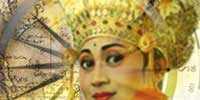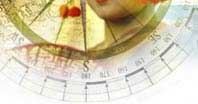|
For millennia, Ubud and the areas immediately surrounding it have been "centre stage" for the fascinating drama of Balinese history. During the Bronze Age (from 300BC), the ubud was already a wellspring of culture. This is evidenced by numerous archeological finds in the area, including megalithic ruins and stepped pyramids, some of which are mow the foundations of active Hindu temples. Remarkable Bronze Age artifacts around Ubud include the enormous bronze gong known as " The Moon of Pejeng". It is still displayed in Pura Panataran Sasih in Pejeng, east of Ubud. Nearby at the archaeological museum in Bedulu are a collection of stone sarcophagi unearthed in the area, which give mute testimony to the death rituals of the its people's ancestors.
In the 8th Century, a Buddhist priest called Rsi Marhandya came to Bali from Java on pilgrimage with a group of followers. He meditated where the East and West Wos Rivers meet in Campuan, on the edge of Ubud, and declared the place holy. Accordingly, a shrine was built, and later expanded by Nirartha, the Javanese priest who is regarded as the father of Bali's religious institutions and practices. This temples is now known as Pura Gunung Lebah or Pura Campuan.
With the spread of Hindu-Buddhist culture in Bali in the 10th to 12th Centuries, Shivaite holymen established hermitages and teaching monasteries near Ubud, at the bequest of local rulers. The temple-memorial complex at Gunung Kawi and the cave temples at Goa Gajah (east and northeast of Ubud) are undoubtedly the most impressive architectural remains from this period. By this time, the people of the Ubud area already practiced sophisticated wet rice farming, kept a variety of livestock and employed techniques of stone and woodcarving, metalworking and thatching that are still very much alive. Many of the dances, drama, puppet plays and elaborate rituals and superstitions that animate Ubud culture today originated in these early kingdoms nearby.
The Balinese legend of Rangda the witch originated in the Ubud area at this time, when the half-Balinese King Airlangga ruled Java And Bali, with its capital located then in Batuan, southeast of Ubud. The Barong and Calinarong dances which visitors still enjoy derived from the story of Airlangga's struggle against the plagues and evil spells cast by Rangda, who is purportedly buried in a tomb near Kutri, southeast of Ubud.
"Thank you for your support"
| 






